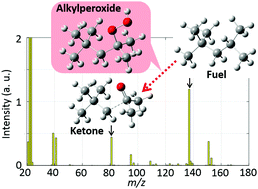Real-time monitoring for reforming processes of liquid hydrocarbon fuel–air pre-mixtures by non-thermal plasmas using ion attachment mass spectrometry
Abstract
Plasma induced reforming processes of fuel–air mixtures were investigated to understand the mechanism of the plasma-assisted combustion technique, which can improve the thermal efficiency and stability of internal combustion engines. In this study, a mixture of air with isooctane or n-heptane fuels was reformed by non-thermal plasma in a flow reactor, generated by a dielectric barrier discharge, and then directly analyzed using ion attachment mass spectrometry. Plasma irradiation of an air/hydrocarbon mixture produced an oxygen atom which then reacted with a hydrocarbon, leading to hydroxyl and alkyl radicals. The alkyl radical was immediately converted to alkyl hydroperoxide, which is suggested to be a long-living intermediate for the fuel reforming process. Finally, ketone and aldehyde were formed through the alkyloxy radical intermediate. The details of each reaction process were investigated by ab initio calculations. The proposed plasma induced fuel reforming processes are strongly supported by the computational results.



 Please wait while we load your content...
Please wait while we load your content...